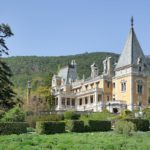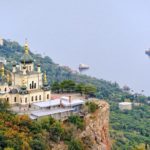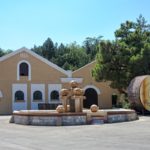Before Lev Golitsyn purchased his estate in Novy Svet, the village was surrounded by what could only be described as a desert. Connected to Sudak by a single mountain road, the village attracted few tourists and was basically unknown. However, it wasn’t long before everything changed, and Prince Golitsyn not only became the first Crimean winemaker but also proved that Russian champagne is superior to French! One variety of his New World champagne was called “Coronation”, having been served to guests at the coronation of the emperor.
Surprisingly, despite the winemaker having achieved huge success and notoriety, Golitsyn disliked courtiers, rarely appeared at court and lived a relatively modest life.
The mountain estate of Lev Golitsyn in Novy Svet is located almost on the shore. Covering an area of more than 110 hectares, the estate included vineyards where more than 500 grape varieties were cultivated and a house where an enoteca of branded wines were stored in the private wine cellars. The peak of development occurred between 1878-1912 at which time Golitsyn gifted it to Emperor Nicholas II. However, after the events of 1917 the property fell into disrepair, and it was only in the 1970s that a group of enthusiasts constructed an exhibition in memory of this great Crimean winemaker.
Golitsyn’s Estate in Crimea: a memorial to the prince and a museum of Crimean winemaking

In France, Golitsyn was known as the “king of experts” for his ability to distinguish the finest shades in wine bouquets. He was described in the memoirs of his contemporaries, as “famous rubbish, an ardent debater, always boasting loudly that he was not ashamed by any ranks and orders …” (Gilyarovsky). He was also called a “wild gentleman” because of his appearance and his propensity to wear a beard, sheepskin coat and hat. Who could imagine that such a person was destined to discover the Crimean Paradise.
The Golitsyn manor in Novy, known as the “Bolshoy House” (Big House), was built in 1880 according to the specifications of the prince himself. While the house is in no way pretentious, a hint of aristocracy is still present.
The original architecture combines classic elements with a Moorish style. Constructed on only one level of a little more than 200 square meters, the red-tiled roof is visible from afar, and a balustrade with columns adds elegance to the façade. The basement was used not only as a place to store wine but also as a tasting room. When guests gathered here, it was lit with many candles.
The basement fireplace also has a special design feature. After the fire was lit the dampers were opened, and smoke filled the basement, thus protecting the walls from damp and mould. Despite the humid marine climate, so many years later, there is still no sign of mould.
What does exposition include?
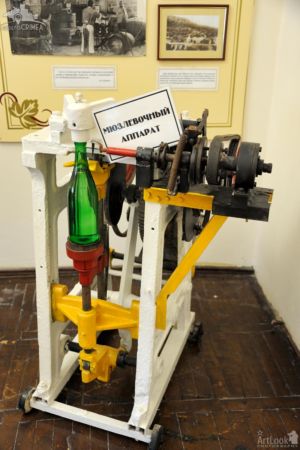
Almost all the sights of Novy Svet are united by stories of how one person subjugated nature, and the beauty of the Crimean landscape is closely linked with the success of these strong personalities.
In the museum exhibition, in the prince’s house, this is also interconnected, and it is easy to imagine how this tall, strong, grey-haired man, sat at his writing desk receiving visitors, and relaxed by studying the beautiful views from his window and from the terrace.
The exhibition includes both personal belongings of the prince and his family, as well as surviving parts of his art collection and library, including tableware; musical instruments; vintage looms from the champagne factory, photographs of the factory and examples of storage for bottles with champagnes in different stages of the production process. Even after the revolution, the house retained its original appearance and furniture, including musical instruments, numerous documents and French books. Here you can also see the grand piano and the writing desk of the prince, while another part of the exhibition is dedicated to the history of winemaking in Crimea.
Today, Lev Golitsyn’s estate also hosts champagne tastings, so it is easy to imagine yourself at some grand social gathering. After all, in its time the Golitsyn Estate was the place where all the Russian aristocracy gathered from all over the country.
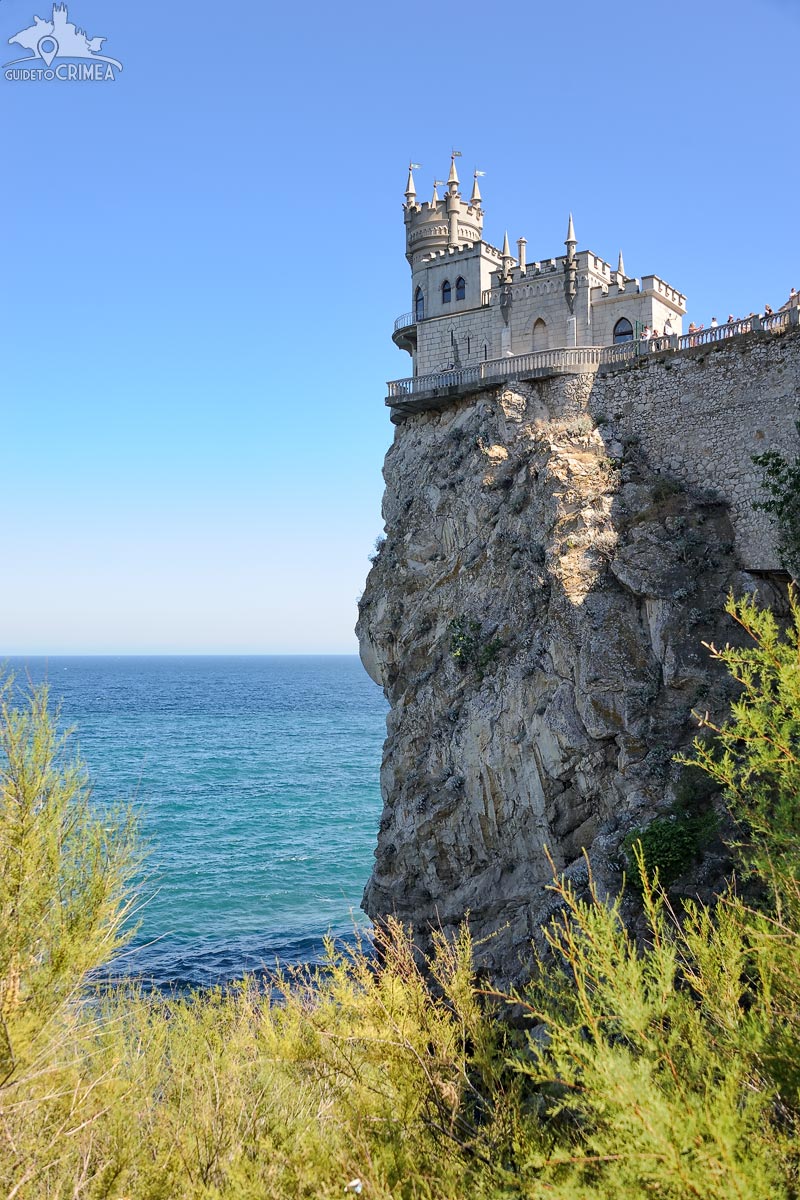
The decorative castle “Swallow Nest” rising on the Aurora Cliff framed by plants in the background of the blue waters of the Black Sea. The small, neo-Gothic decorative castle was built in Gaspra (13 km from Yalta by car) in 1911-1912 closer in style to various German Gothic castle follies, such as Lichtenstein Castle, specifically to catch visitors' attention with its fairy tale appearance. It is the most famous landmark and symbol of Crimea.
Photo #387 taken on August 14, 2019 in Gaspra on the 4th day of the adventure trip “Discovering Crimea in 6 Days” with my dear clients from Hong Kong, Esther and Ricky.
| Album | Swallow's Nest Castle in Gaspra |
| Categories | Architectural, Landscapes |
| Taken | August 14, 2019 |
| Uploaded | March 28, 2021 |
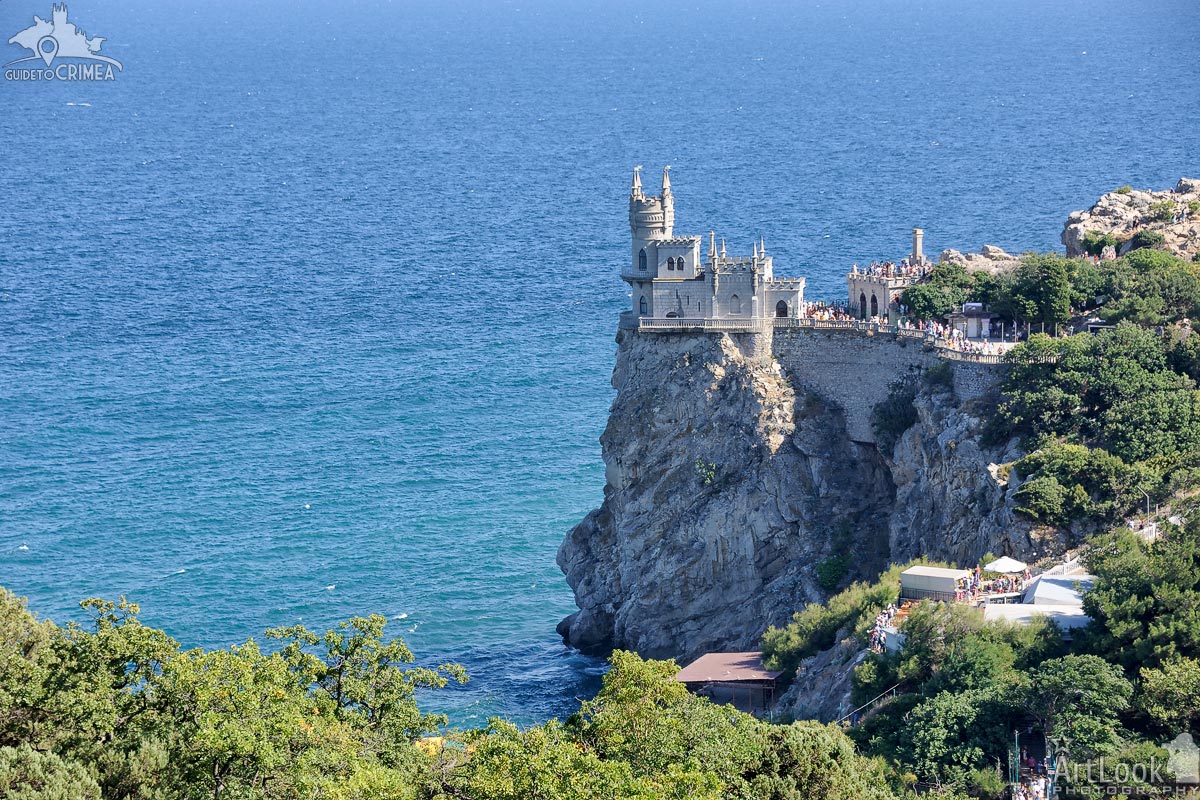
View from the observation platform at Alupkinskoye highway on the decorative castle “Swallow Nest” rising on the Aurora Cliff in the background of the blue waters of the Black Sea. The small, neo-Gothic decorative castle was built in Gaspra (13 km from Yalta by car) in 1911-1912 closer in style to various German Gothic castle follies, such as Lichtenstein Castle, specifically to catch visitors' attention with its fairy tale appearance. It is the most famous landmark and symbol of Crimea.
Photo #432 taken on August 14, 2019 in Gaspra on the 4th day of the adventure trip “Discovering Crimea in 6 Days” with my dear clients from Hong Kong, Esther and Ricky.
| Album | Swallow's Nest Castle in Gaspra |
| Categories | Architectural, Cultural, Landscapes |
| Taken | August 14, 2019 |
| Uploaded | March 20, 2021 |
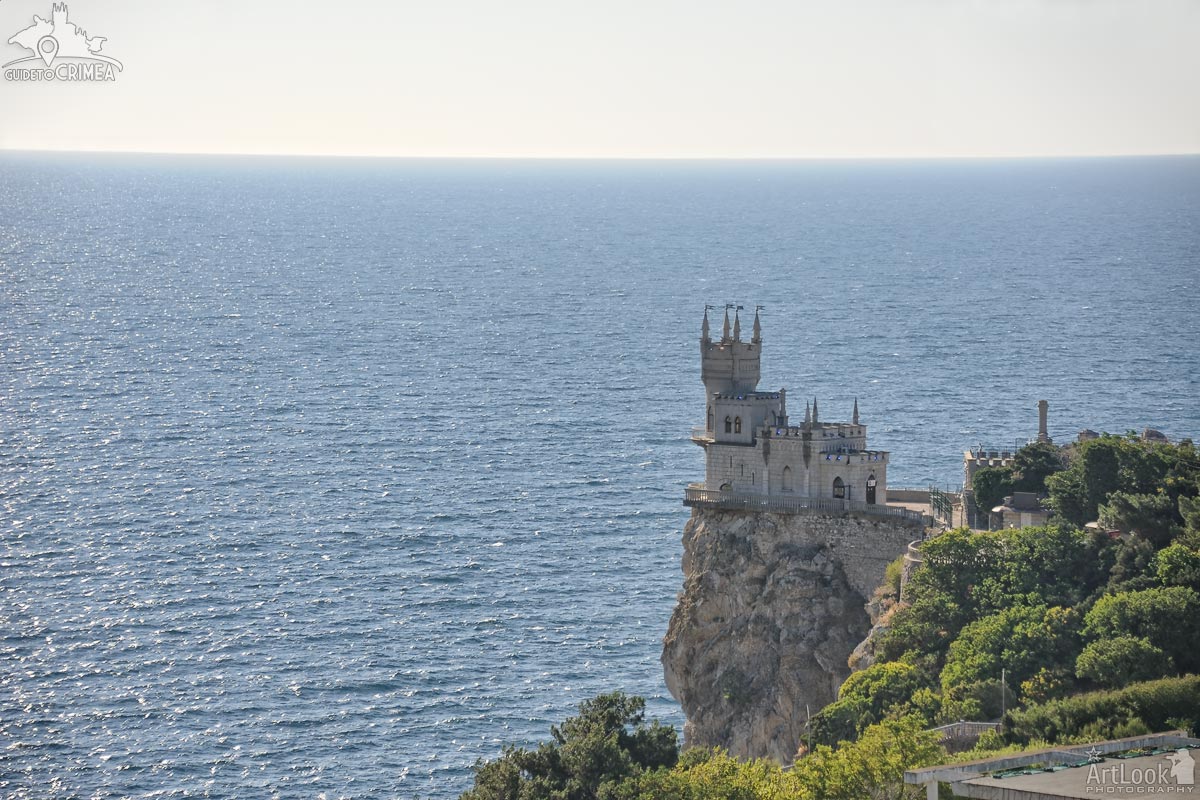
Amazing view from a parking area at Alupkinskoye highway on the decorative castle “Swallow Nest” rising on the Aurora Cliff above the blue waters of the Black Sea in early summer morning. The small, neo-Gothic decorative castle was built in Gaspra (13 km from Yalta by car) in 1911-1912 closer in style to various German Gothic castle follies, such as Lichtenstein Castle, specifically to catch visitors' attention with its fairy tale appearance. It is the most famous landmark and symbol of Crimea.
Photo #005 taken on August 14, 2019 in Gaspra on the 4th day of the adventure trip “Discovering Crimea in 6 Days” with my dear clients from Hong Kong, Esther and Ricky.
| Album | Swallow's Nest Castle in Gaspra |
| Category | Architectural |
| Taken | August 14, 2019 |
| Uploaded | October 26, 2019 |

Beautiful view at the beginning of hiking tour to the peak of Sokol mount on the Green Bay, Koba-Kaya Mountain (Mount Orel, Eagle), and resort settlement Novy Svet (New World).
Photo #083 taken on August 31, 2015
| Album | Mount Falcon (Kush-Kaya) in Novy Svet |
| Category | Landscapes |
| Taken | August 31, 2015 |
| Uploaded | October 23, 2019 |

Angle view of the interior of the Cabinet of His Imperial Majesty in Massandra Palace made by the tradition of classicism. Molded elements with gilding are successfully implemented in the strict ceiling design (master M. A. Zhilkin). The useful area of the cabinet was increased due to a niche at the northern facade of the palace. Niche, doors, panels are made of walnut, in harmony with the fireplace, lined with gray marble (at the right). Items of furniture and arts and crafts are typical for palace interiors at the turn of the XIX-XX centuries.
A sculpture of the horse of the German master Slodenbek (Berlin, beginning of the XX century) is placed on a round table with a carved table stand (the work of Russian masters of the late XIX century) in the middle of the cabinet. Armchairs around the table by Russian masters of the first third of the 19th century in the Empire style are ornamented with gilded woodcarvings in the form of laurel wreaths, garlands, stylized military armor. In the depths of the niche is a marble bust of Emperor Alexander II (1818-1881), the sovereign reformer, made by an unknown sculptor in the early 60s of XIX century.
Photo #084 taken on August 13, 2019 during visiting Massandra Palace with my dear clients from Hong Kong, Esther and Ricky on the 3rd day of the adventure trip “Discovering Crimea in 6 Days”.
| Album | Massandra Estate |
| Category | Architectural |
| Taken | August 13, 2019 |
| Uploaded | October 23, 2019 |

19th century muselet (or muzzler) machine to put wire cage on a bottle of champagne on display in the house-museum of the famous Russian winemaker, Lev Golitsyn, in Novy Svet.
Photo #240 taken on August 12, 2019 on the 2nd day of the adventure trip “Discovering Crimea within 6 Days”) with my Dear clients from Hong Kong, Esther and Ricky.
| Album | Golitsyn’s House-Museum in Novy Svet |
| Category | Cultural |
| Taken | August 12, 2019 |
| Uploaded | October 17, 2019 |

Old wooden worktable, shelf with books, family pictures and the portrait of Lev Golitsyn hanging on the wall, in the living room of the house-museum of the famous Russian winemaker in Novy Svet.
Photo #232 taken on August 12, 2019 on the 2nd day of the adventure trip “Discovering Crimea within 6 Days”) with my Dear clients from Hong Kong, Esther and Ricky.
| Album | Golitsyn’s House-Museum in Novy Svet |
| Category | Cultural |
| Taken | August 12, 2019 |
| Uploaded | October 16, 2019 |
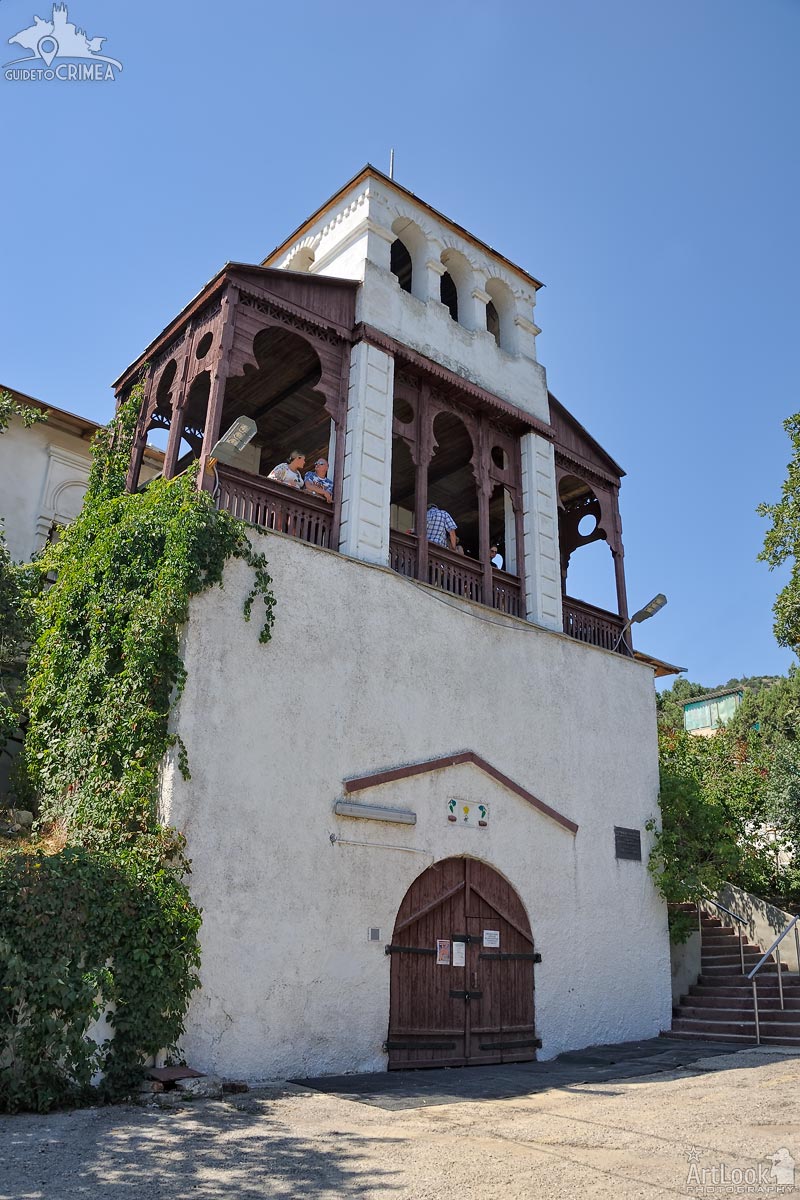
View on the “Bolshoy House” (Big House) of Golitsyn’s family in Novy Svet from the entrance doors into the grand winery cellar of the famous Russian winemaker. A wooden column balustrade above the cellar is located on the high level in front of the main entrance into the one story 200 square meter house constructed by project of Lev Golitsyn in 1880. Due to the difference in relief at the Mount Koba-Kaya (Orel / Eagle Mountain), the building stands on such a high basement.
Photo #208 taken on August 12, 2019 on the 2nd day of the adventure trip “Discovering Crimea within 6 Days”) with my Dear clients from Hong Kong, Esther and Ricky.
| Album | Golitsyn’s House-Museum in Novy Svet |
| Category | Architectural |
| Taken | August 12, 2019 |
| Uploaded | October 16, 2019 |

Porcelain sculpture of the main characters from the novel of Anton Pavlovich Chekhov “Three Sisters” created by sculptor Brzezinskaya A.D. on display in the house-museum “Dacha Chekhova” in Gurzuf, Crimea.
Photo #062 taken on September 10, 2013
| Album | Chekhov's Dacha in Gurzuf |
| Category | Art Works |
| Taken | September 10, 2013 |
| Uploaded | October 15, 2019 |
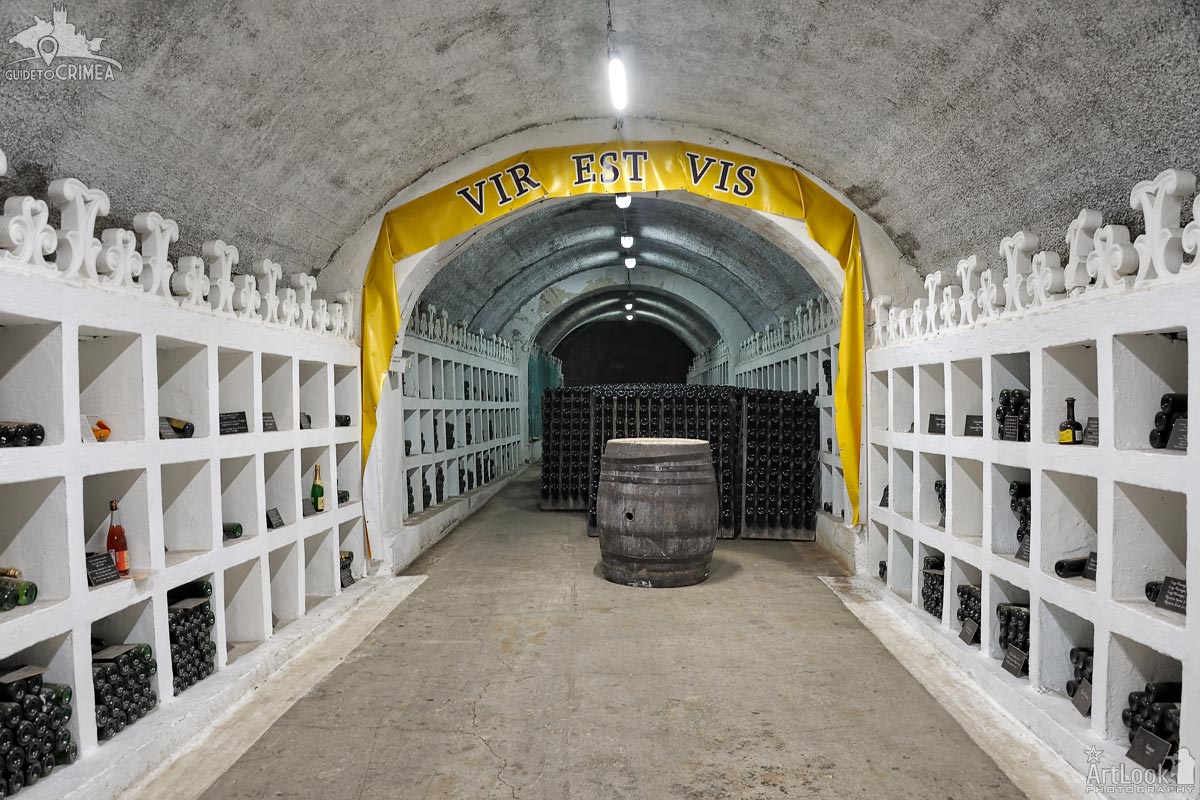
Interior of Enoteca of Novy Svet Winery, the repository of elite sparkling wines, in one of the old tunnels cut in the monolith of Koba-Kaya Mountain (Mount Orel, Eagle) at the end of 19th – beginning of 20th century. In the tunnel is hanging the yellow banner with the words Vir, Est, Vis (“It was. It is. It will be.”) from the coat of arms of Golitsyn family. Several tunnels were constructed below the sea level, so it helps to maintain permanent temperature of 8-12 degrees necessary for aging. The old tunnel cellars are in perfect condition, and most of them are used by the Novy Svet Winery even today.
Photo #278 taken on August 12, 2019 during Champaigne Factory tour in Novy Svet on the 2nd day of the adventure trip “Discovering Crimea in 6 Days” with my dear clients from Hong Kong, Esther and Ricky.
| Album | Novy Svet Champagne Factory |
| Taken | August 12, 2019 |
| Uploaded | October 13, 2019 |
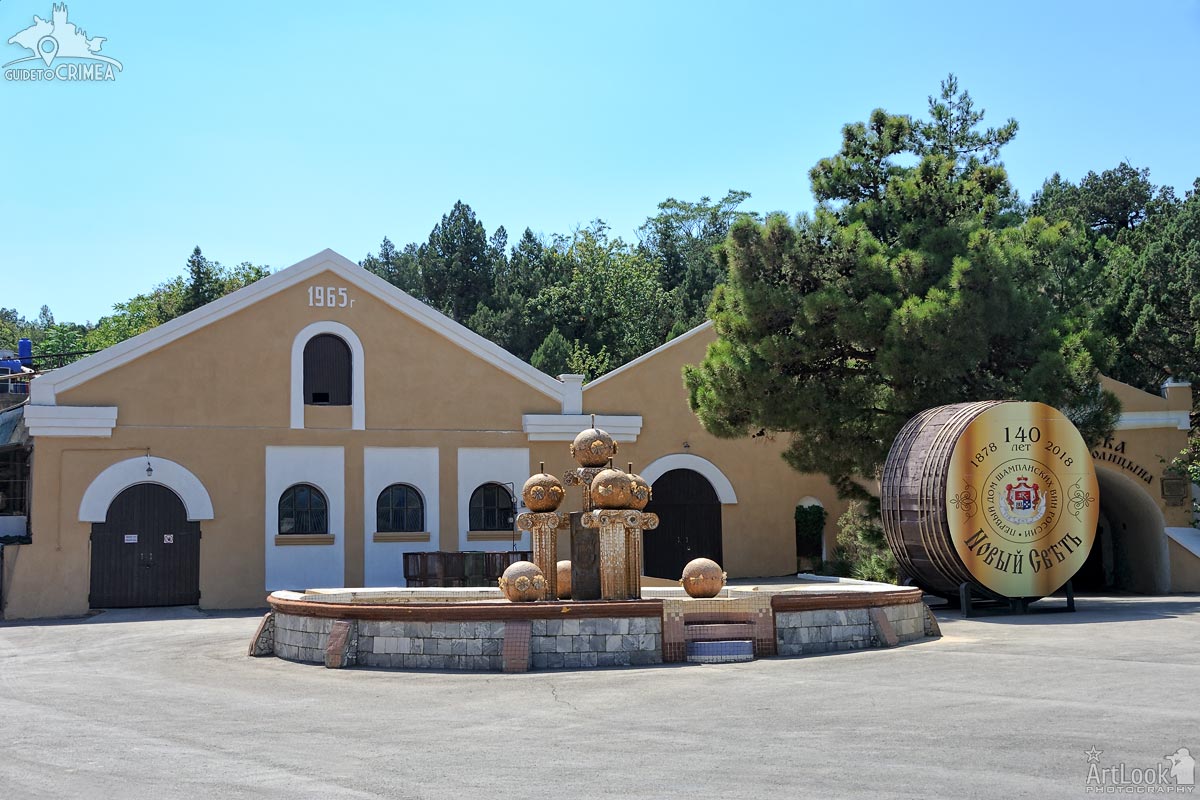
ountain in background of production buildings with sign 1965 on the main square of the champagne factory “Novy Svet”.
Photo #284 taken on August 12, 2019 during Champaigne Factory tour in Novy Svet on the 2nd day of the adventure trip “Discovering Crimea in 6 Days” with my dear clients from Hong Kong, Esther and Ricky.
©2019 GuideToCrimea.Ru by Arthur Lookyanov
| Album | Novy Svet Champagne Factory |
| Taken | August 12, 2019 |
| Uploaded | October 13, 2019 |
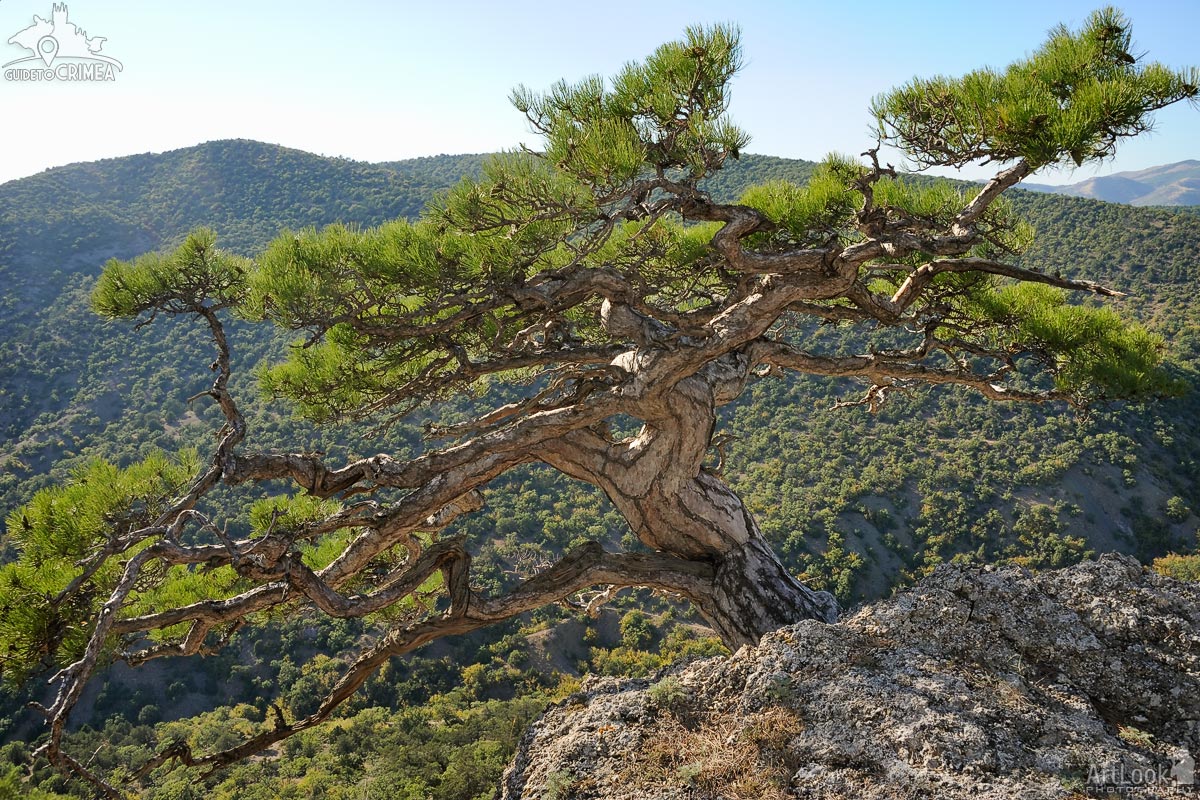
This exceptional Stankevich pine grows on a steep slope, almost at the peak (about 410 metres above sea level) of Sokol (Falcon) mountain in Novy Svet (New World). Such pine trees are very rare in nature, but they are endemic to the Sudak district on the southern coast of the Crimea peninsula. First described by the Russian botanist V.N. Stankevich, the pines were named by the academic V. N. Sukachev in 1906 in his honor. They are also known as “Sudak Pines”- after the region in which they are found. The pine tree in this photograph is about 200 years old.
Photo #222 taken on August 31, 2015
| Album | Mount Falcon (Kush-Kaya) in Novy Svet |
| Category | Landscapes |
| Taken | August 31, 2015 |
| Uploaded | October 10, 2019 |
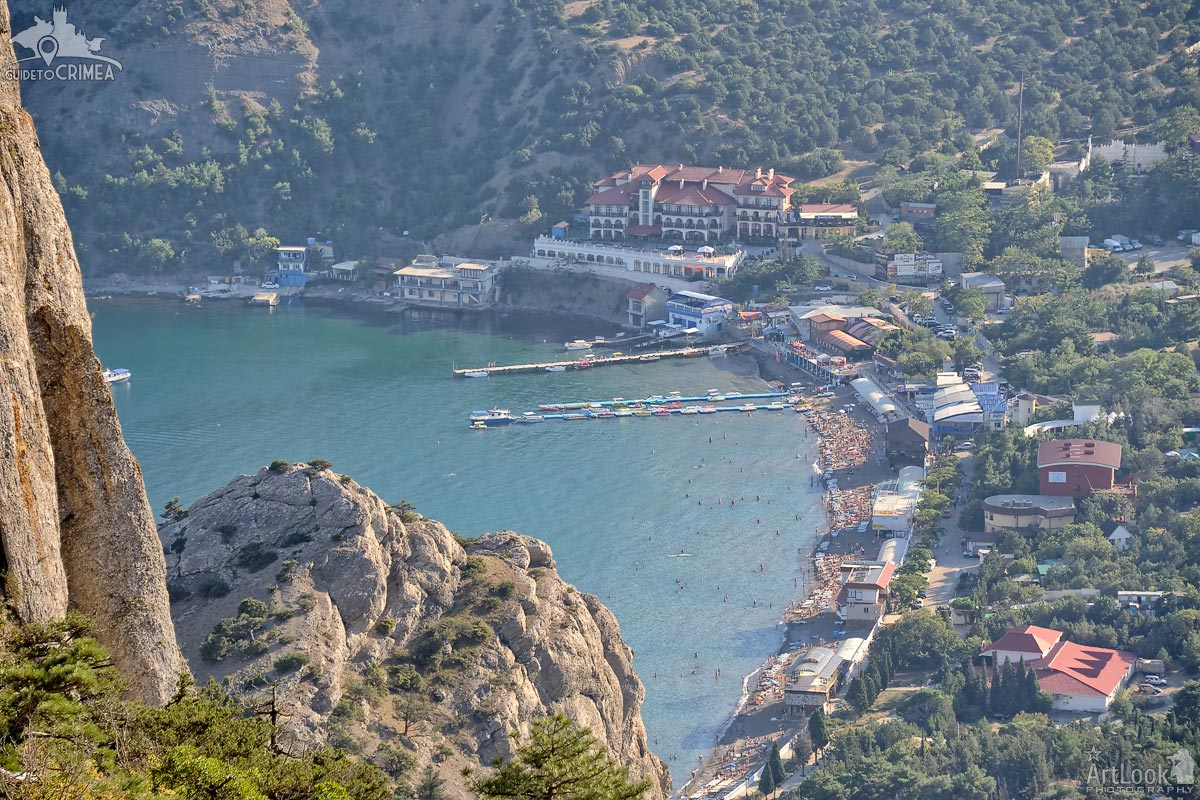
Overlooking the beach of settlement Novy Svet (New World) from Sokol Mountain at the height about 350 meters. The settlement is located about 6 km West from Sudak at picturesque Zelenaya Buhta (Green Bay). This tranquil bay with its crystal clear water is protected from wind on both sides by imposing mountains.
Photo #253 taken on August 31, 2015
| Album | Mount Falcon (Kush-Kaya) in Novy Svet |
| Category | Landscapes |
| Taken | August 31, 2015 |
| Uploaded | October 10, 2019 |
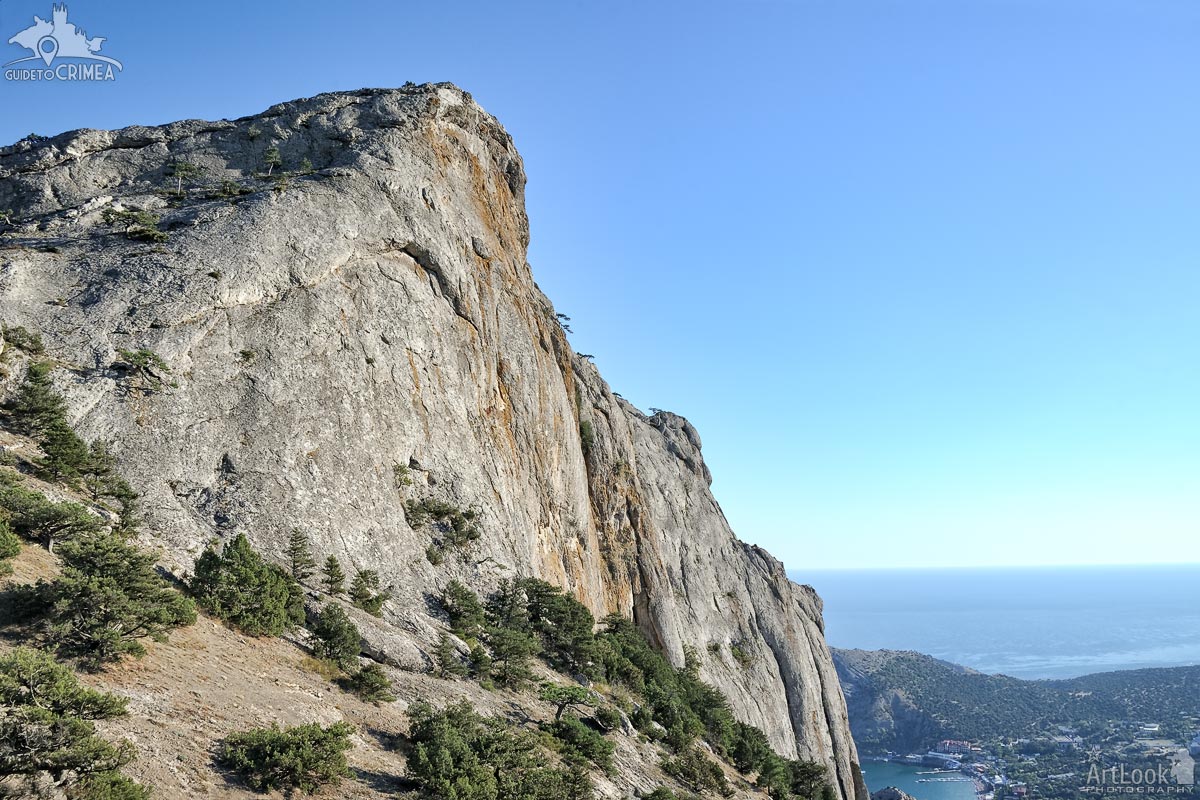
View at the peak of Sokol (Falcon) Mountain, 474 meters above the level of Black Sea, peaceful “Zelenaya Buhta" (Green Bay) and the settlement of Novy Svet (New World), down the mountain at sunset.
Photo #254 taken on August 31, 2015
| Album | Mount Falcon (Kush-Kaya) in Novy Svet |
| Category | Landscapes |
| Taken | August 31, 2015 |
| Uploaded | October 10, 2019 |
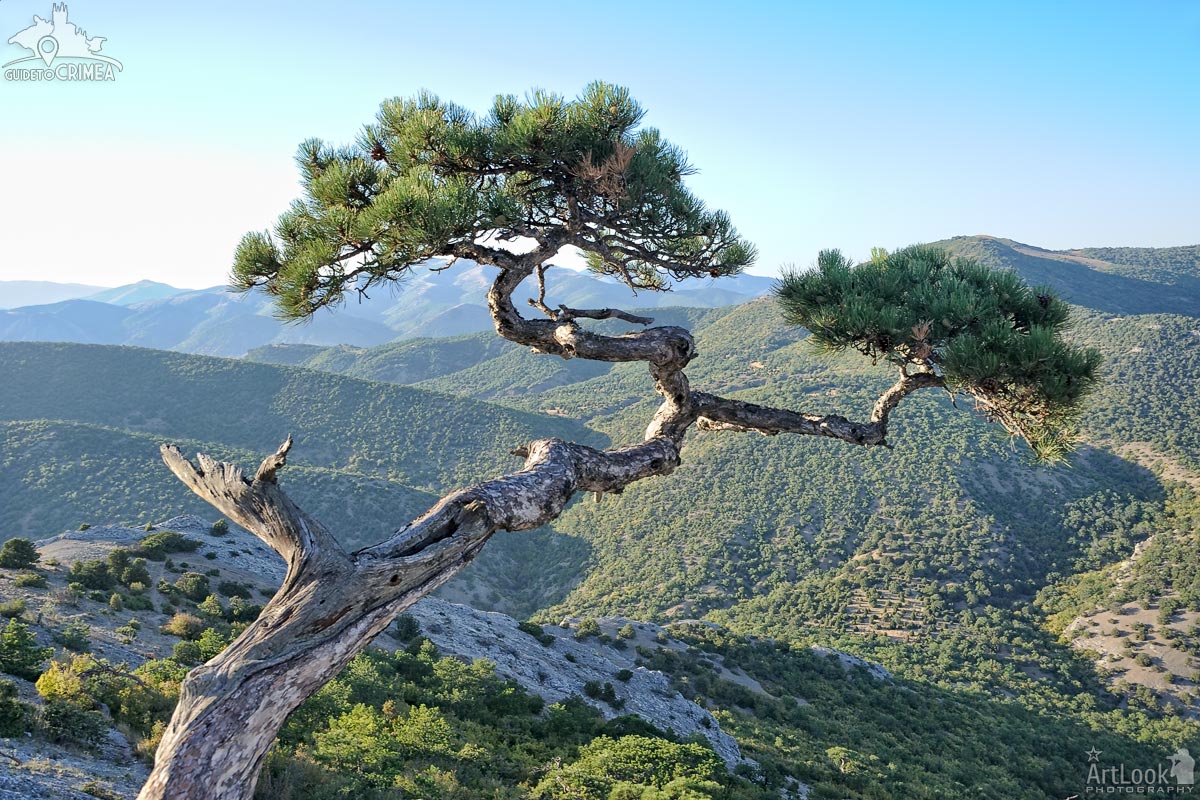
Beautiful Crimean landscape with the exceptional Stankevich pine growing on a slope of Sokol (Falcon) Mountain in Novy Svet (New World) in the background of the mountain range.
Such pine trees are very rare in nature, but they are endemic to the Sudak district on the southern coast of the Crimea peninsula. First described by the Russian botanist V.N. Stankevich, the pines were named in his honor by the academic V. N. Sukachev in 1906. They are also known as “Sudak Pines”- after the region in which the trees were found.
Photo #348 taken on August 31, 2015
| Album | Mount Falcon (Kush-Kaya) in Novy Svet |
| Category | Landscapes |
| Taken | August 31, 2015 |
| Uploaded | October 10, 2019 |
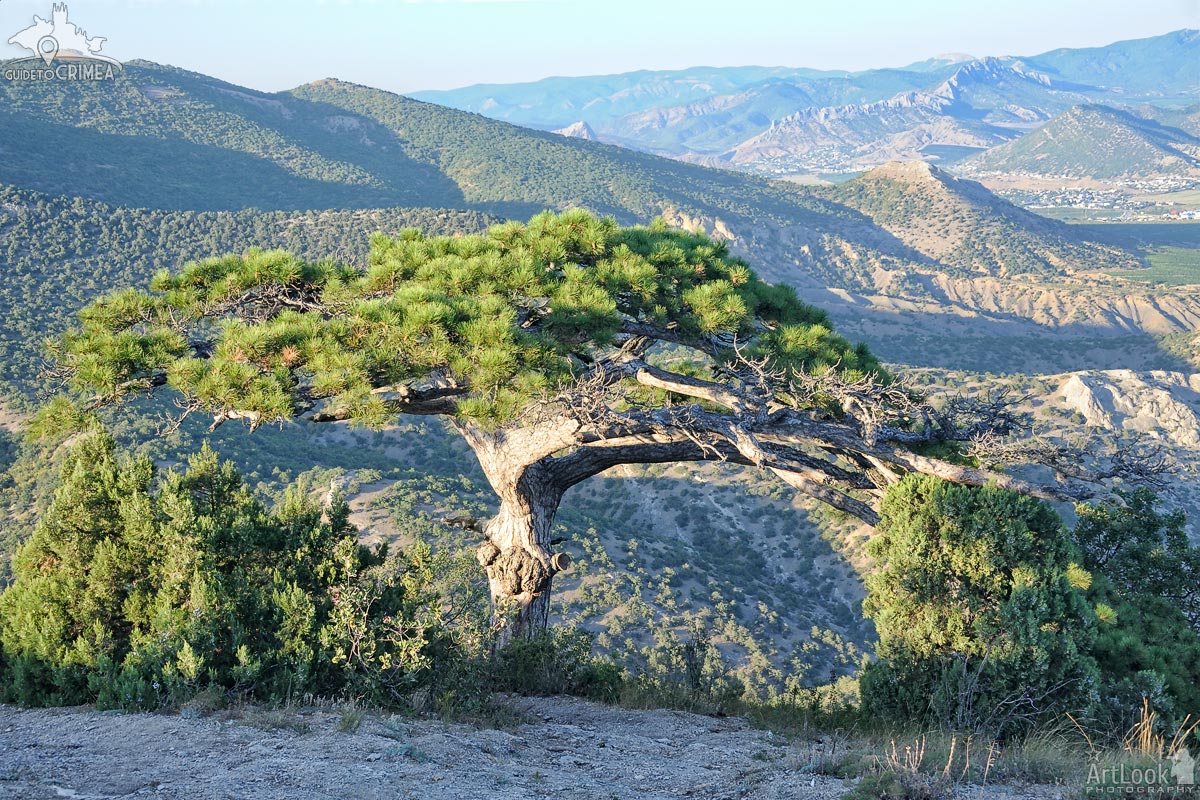
The big Sudak pine on the slope of Sokol Mountain (Falcon Mountain) in Novy Svet in the background of the mountain range in Sudak district. The tree is used by people who climb on the mount as an object of wishes and offerings. This type of trees in Sudak was called Stankevich pine by the name of famous Russian botanist who found and described it in 1906.
Photo #384 taken on August 31, 2015
| Album | Mount Falcon (Kush-Kaya) in Novy Svet |
| Category | Landscapes |
| Taken | August 31, 2015 |
| Uploaded | October 10, 2019 |
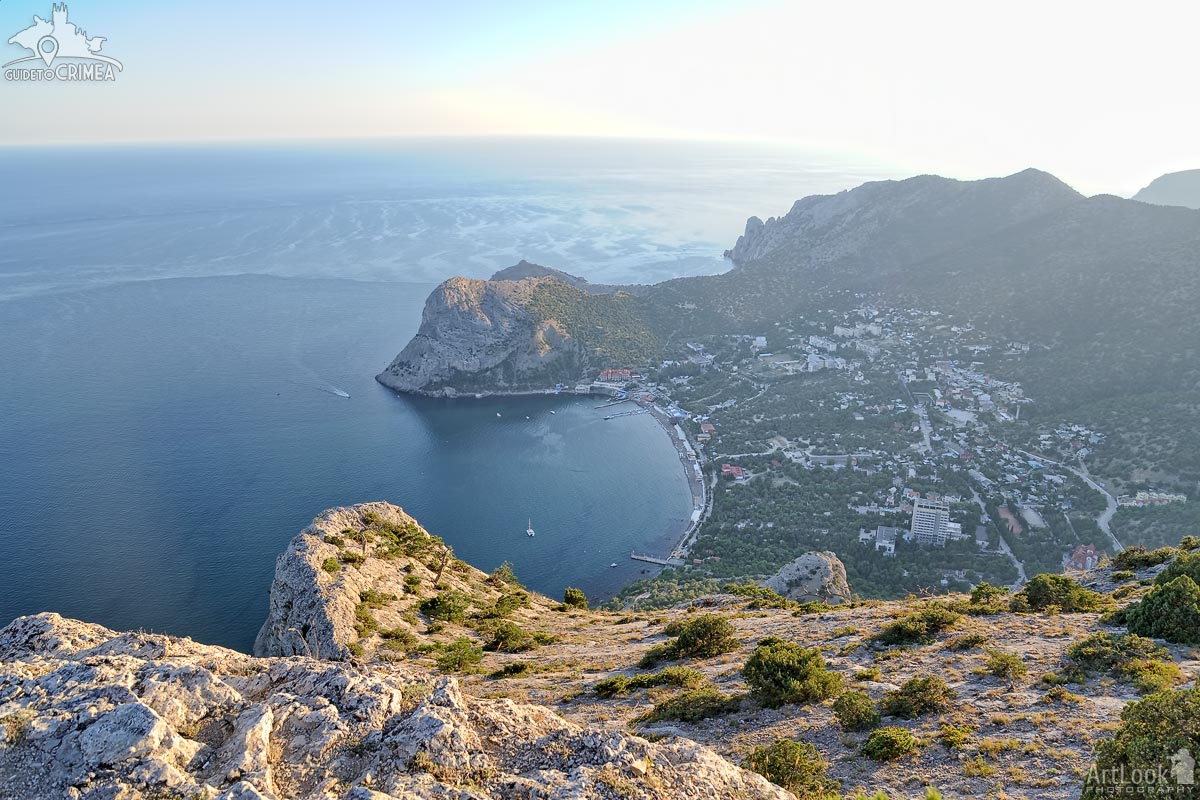
Breathtaking view from the peak of Sokol (Falcon) Mountain, which lies 474 metres above the peaceful “Zelenaya Buhta" (Green Bay) and the settlement of Novy Svet (New World), Crimea. This tranquil bay with its crystal clear water is protected on both sides by imposing mountains.
Photo #426 taken on September 31, 2015
| Album | Mount Falcon (Kush-Kaya) in Novy Svet |
| Category | Landscapes |
| Taken | August 31, 2015 |
| Uploaded | October 10, 2019 |
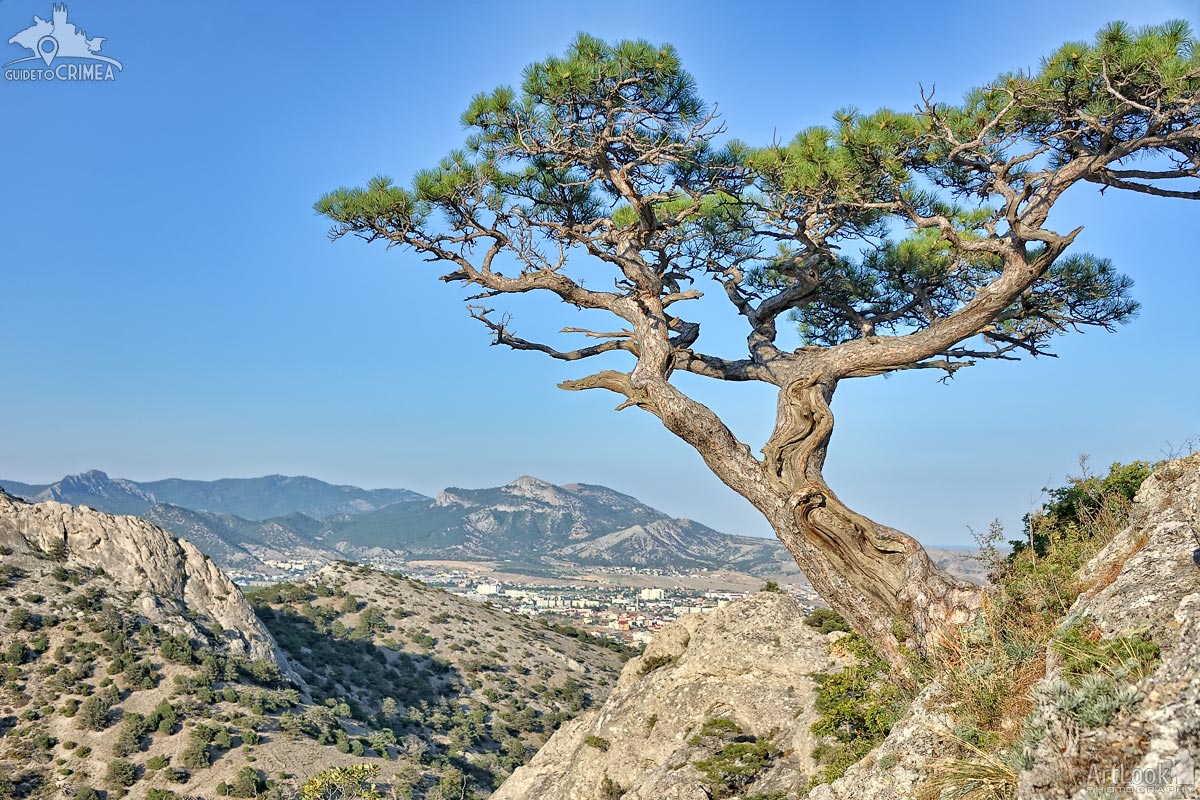
Beautiful Stankevich pine tree growing on a steep slope of Sokol (Falcon) mountain in background of a valley where located Sudak city. Such pine trees are very rare in nature, but they are endemic to the Sudak district on the southern coast of the Crimea peninsula. First described by the Russian botanist V.N. Stankevich, the pines were named by the academic V. N. Sukachev in 1906 in his honor. They are also known as “Sudak Pines”- after the region in which they are found.
Photo #149 taken on August 11, 2019 during hiking tour on the peak of Sokol mountain with my dear clients from Hong Kong, Esther and Ricky (1st day of the adventure trip “Discovering Crimea within 6 Days”)
| Album | Mount Falcon (Kush-Kaya) in Novy Svet |
| Category | Landscapes |
| Taken | August 11, 2019 |
| Uploaded | October 10, 2019 |

Overview beautiful sunset over Crimean Mountains from the peak of Sokol (Falcon) mountain (about 470 meters from a sea level) at Novy Svet, few kilometers from Sudak, the Sothern shore of Crimean Peninsula.
Photo #208 taken on August 11, 2019 during hiking tour on the peak of Sokol mountain with my dear clients from Hong Kong, Esther and Ricky (1st day of the adventure trip “Discovering Crimea within 6 Days”)
| Album | Mount Falcon (Kush-Kaya) in Novy Svet |
| Category | Landscapes |
| Taken | August 11, 2019 |
| Uploaded | October 10, 2019 |
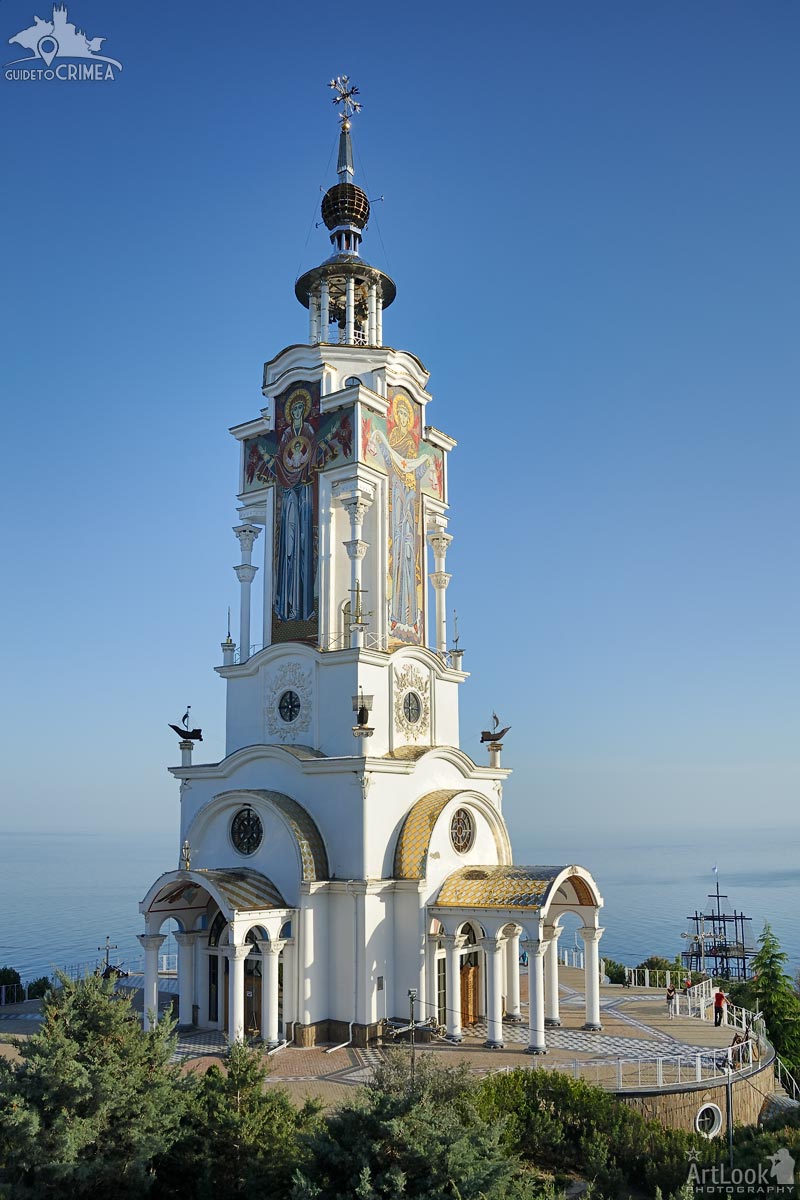
Beautiful view on the church-lighthouse of St. Nicholas of Myra at Malorechenskoye village at sunset. The unique project located few kilometers from Alushta became a part of the Memorial Complex "In Memory of the Dead on the Waters" opened on May 7, 2009. A patron and sponsor of the project became the Russian businessmen Alexander Lebedev, who took a decision and invested funds in constructing here the new Crimean Wonder in 2004.
Photo #215 taken on May 01, 2017
| Album | St. Nicholas Church-Lighthouse in Malorechenskoye |
| Category | Architectural |
| Taken | May 1, 2017 |
| Uploaded | October 8, 2019 |
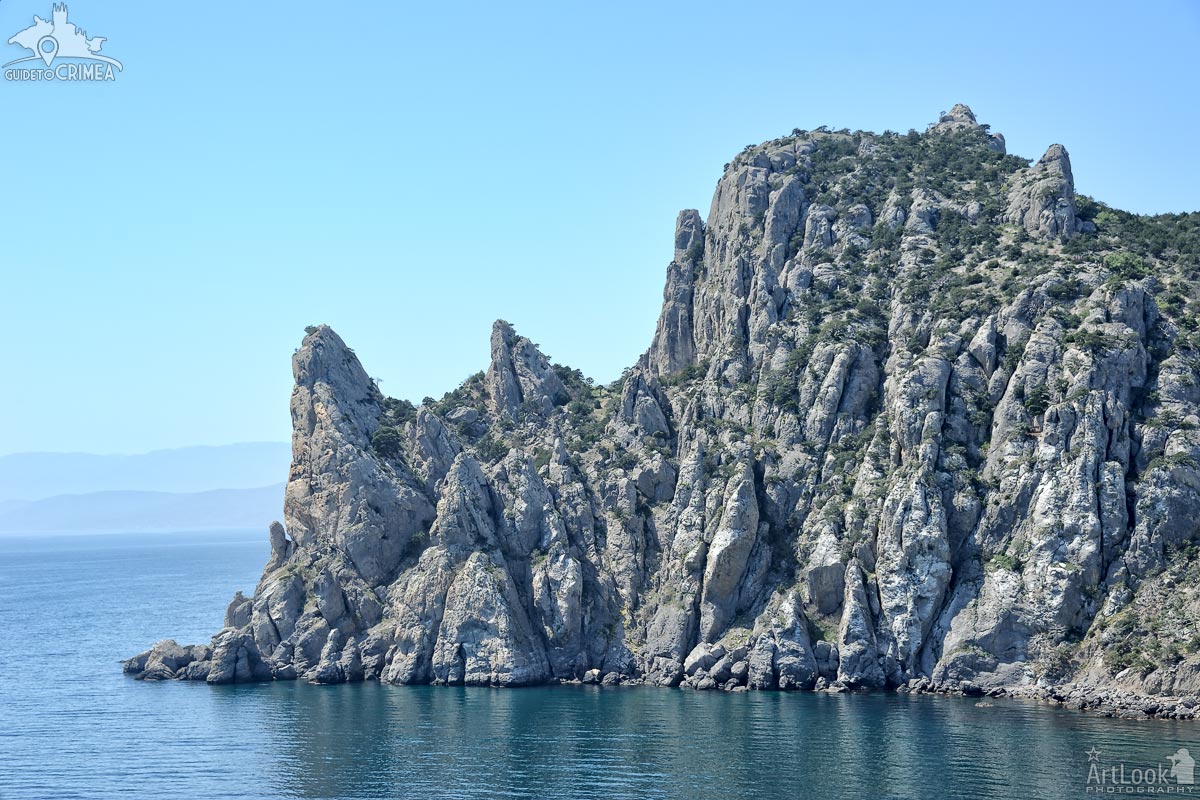
The view on the edge of the ancient coral reef of the Jurassic period, the mount Karaul-Oba (Tatar: Qaravul Oba, Russian: Karaulnaya), from Cape Kapchik, located a few kilometers westwards from Novy Svet (New World) settlement, on the tourist path of Golitsyn. The Karaul-Oba massif with its mystic rocky ledges is the state complex natural monument. Almost from the very sea, sharp teeth of the cliffs are jutting out, that is a distinctive feature of the mountain. ‘Karaul-Oba’ means ‘Watch Mountain’ or ‘Guard Peak’ in Crimean Tatar. It is reckoned among many unique natural wonders of Sudak’s surroundings.
Photo #079 taken on May 01, 2017
| Album | Golitsyn Trail in Novy Svet |
| Category | Landscapes |
| Taken | May 1, 2017 |
| Uploaded | October 7, 2019 |
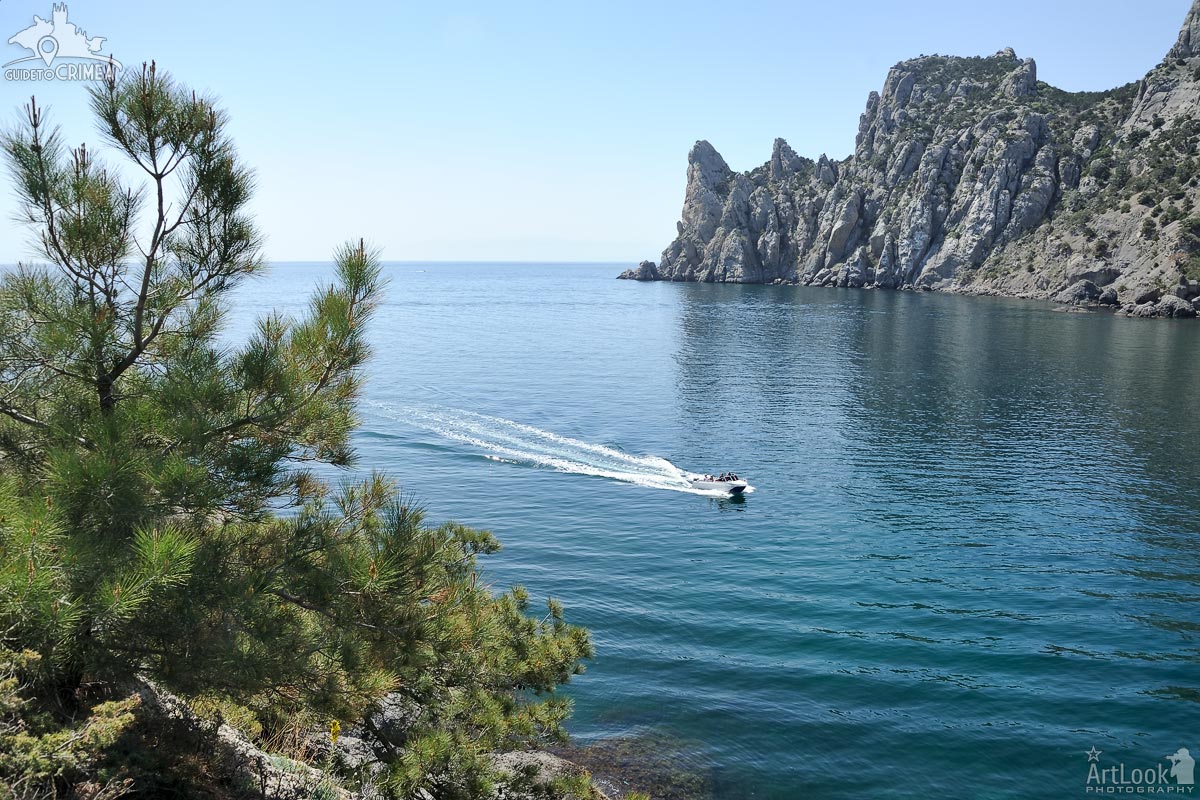
View of a boat with tourists entering the Blue Bay (Golubaya Buhta) in Novy Svet (New World), where located the famous Tsar beach in Suzdak district in Crimea. The sharp teeth of the cliffs of the mount Karaul-Oba (Tatar: Qaravul Oba, Russian: Karaulnaya) are in the background of the picture. This ancient 341-meter-high coral reef of the Jurassic period (341 m.) has rather a complicated specific structure: plateau-like area with rock walls, crevices, ridges, stone labyrinths are replaced by deep long saddles. The rocky ledges of Karaul-Oba massif is a State complex natural monument and reckoned among many unique natural wonders of Sudak’s surroundings.
Photo #095 taken on May 01, 2017
| Album | Golitsyn Trail in Novy Svet |
| Category | Landscapes |
| Taken | May 1, 2017 |
| Uploaded | October 7, 2019 |
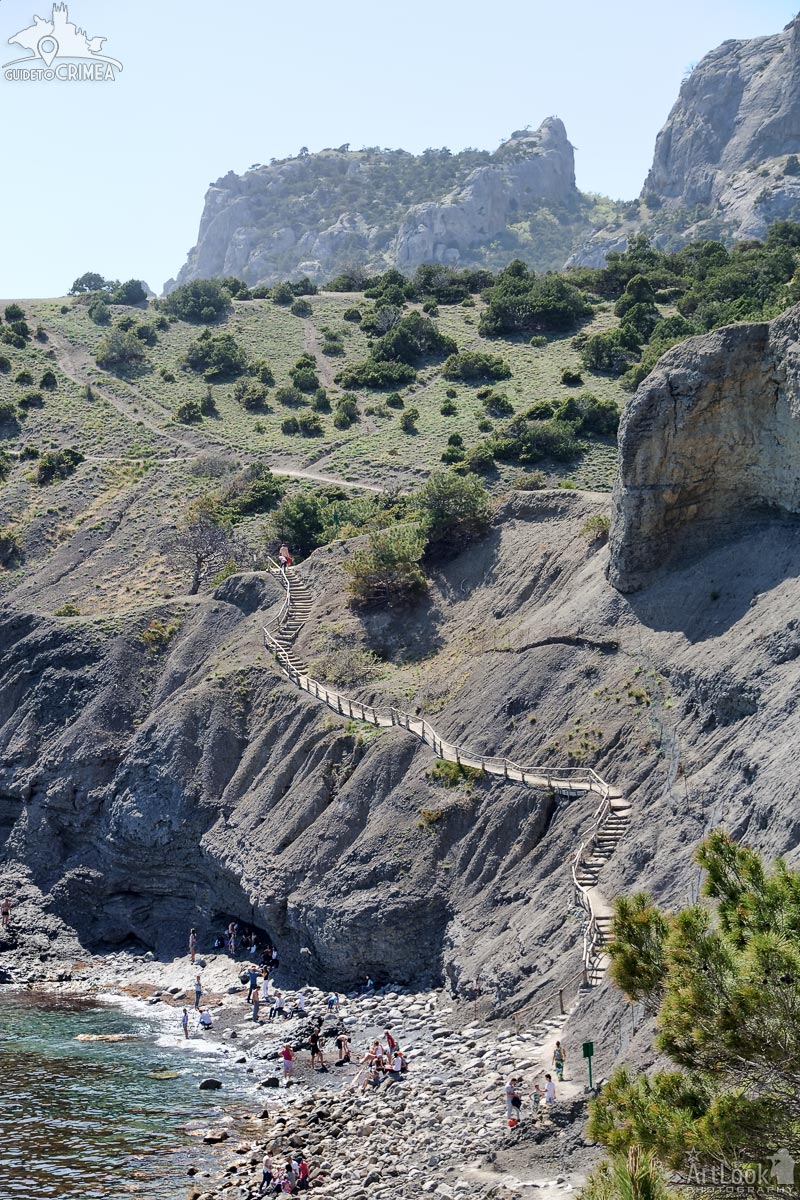
View on the famous Golitsyn trail and rocky beach with small cave near settlement Novy Svet (New World) near the cape Kapchik.
Novy Svet (New World) settlement is the well-known resort in Sudak district, the South-eastern part of the Crimean Peninsula, Black Sea, Russian Federation, that boasts its beautiful landscapes, mountains, beaches and factory of sparkling vines established by Prince Lev Golitsyn in 1878.
Photo #150 taken on May 01, 2017
| Album | Golitsyn Trail in Novy Svet |
| Category | Landscapes |
| Taken | May 1, 2017 |
| Uploaded | October 7, 2019 |
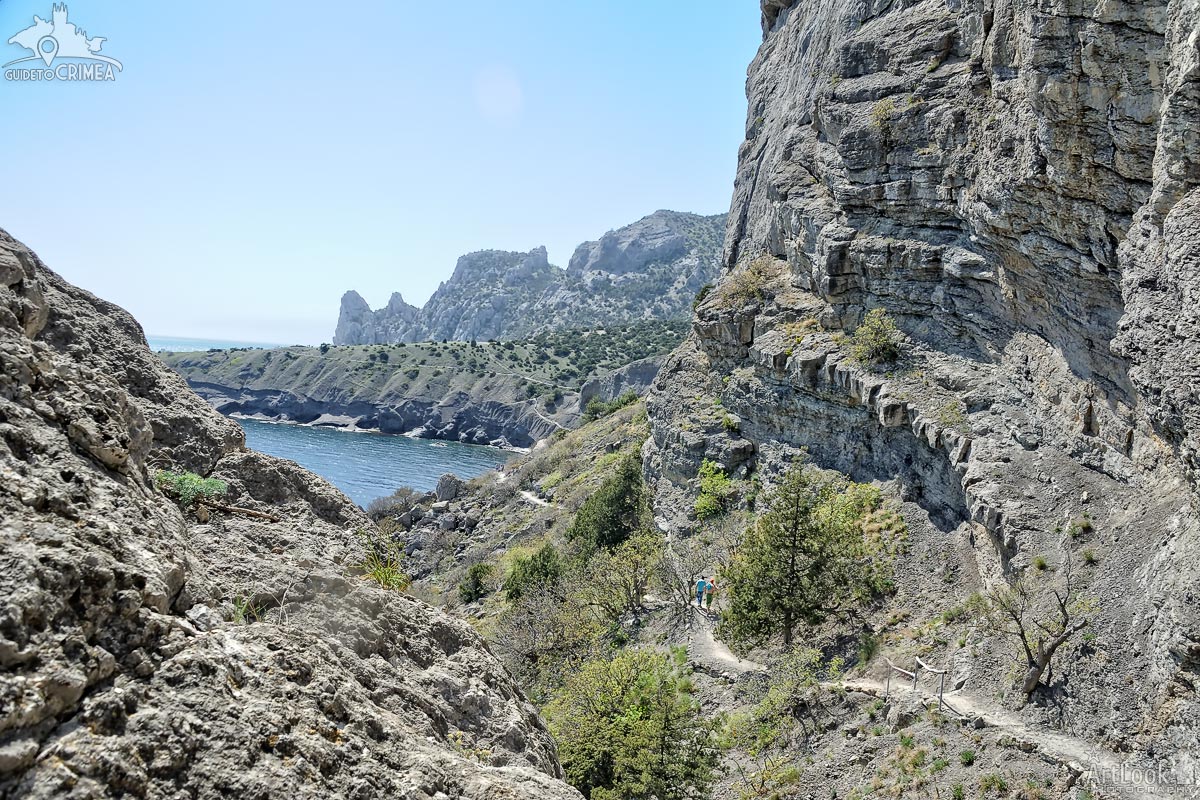
Walking between rocks along the famous trail Golitsyn to the cape Kapchik and the mount Karaul-Oba (Karaulnaya), the ancient 341-meter-high coral reef of the Jurassic period., located near Novy Svet (New World) settlement.
Novy Svet (New World) settlement is the well-known resort in Sudak district, the South-eastern part of the Crimean Peninsula, Black Sea, Russian Federation, that boasts its beautiful landscapes, mountains, beaches and factory of sparkling vines established by Prince Lev Golitsyn in 1878.
Photo #160 taken on May 01, 2017
| Album | Golitsyn Trail in Novy Svet |
| Category | Landscapes |
| Taken | May 1, 2017 |
| Uploaded | October 7, 2019 |
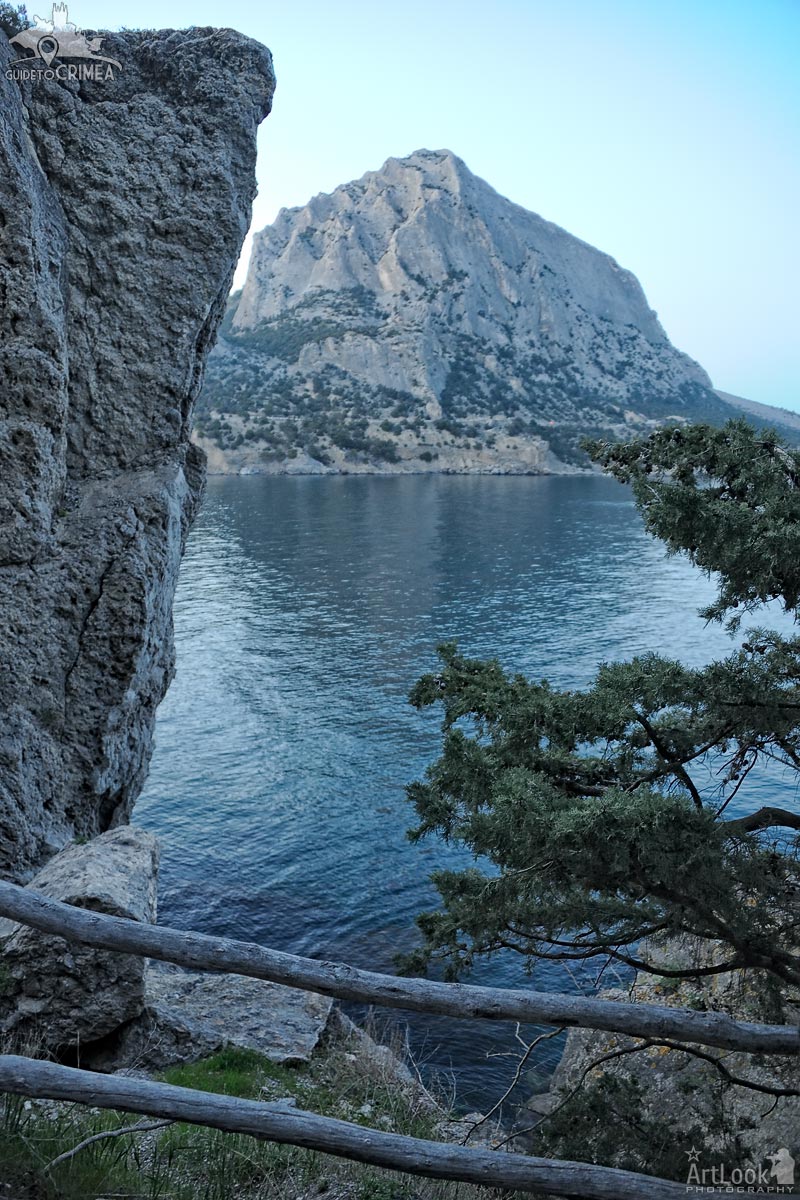
View from a tourist path of Golitsyn on the Sokol (Falcon) Mountain framed by a pine tree and a rock at the bottom of Oryol (Eagle) Mountain at Novy Svet (New World) settlement after sunset, before it was get dark. The popular village-resort is located on the coast of the Zelenaya Buhta (Green Bay) between these mountains.
Photo #388 taken on April 30, 2017
| Album | Golitsyn Trail in Novy Svet |
| Category | Landscapes |
| Taken | April 30, 2017 |
| Uploaded | October 7, 2019 |
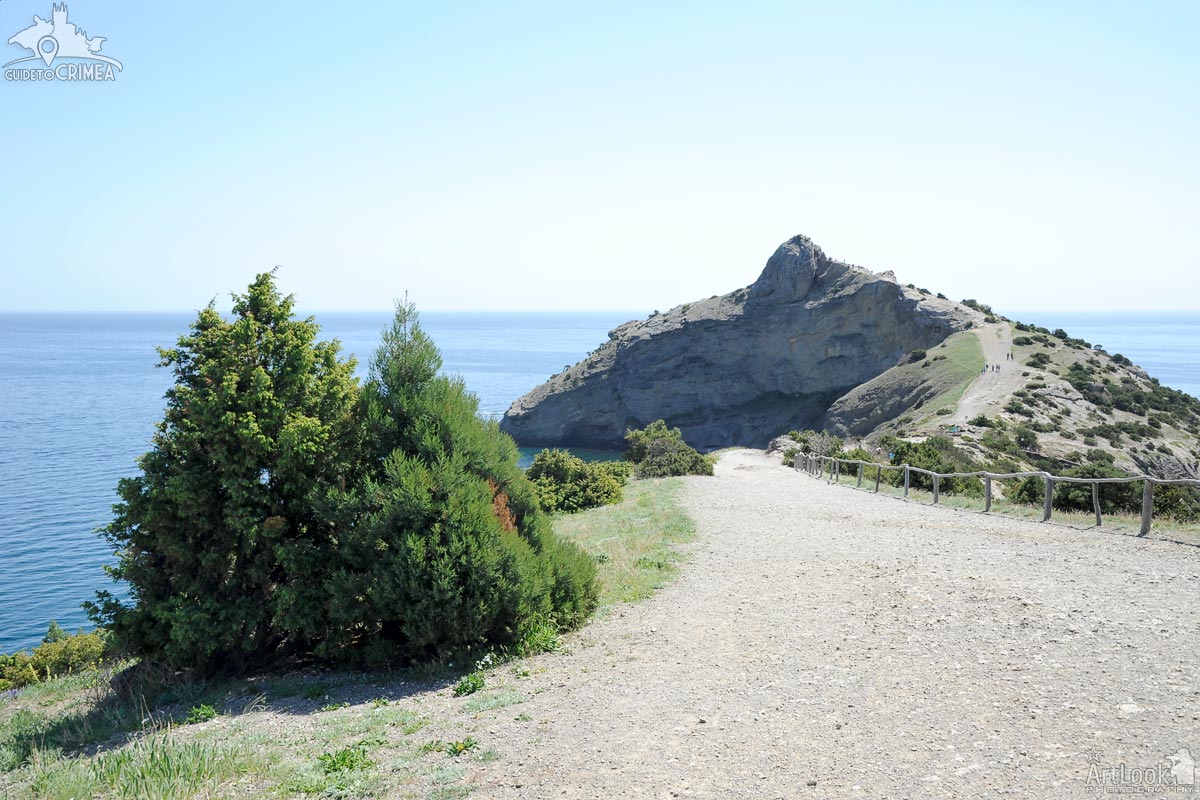
Walking along the famous trail Golitsyn to the cape Kapchik near Novy Svet (New World) settlement, the well-known resort in the South-eastern part of the Crimean Peninsula, Black Sea, Russian Federation.
Photo #040 taken on May 01, 2017
| Album | Golitsyn Trail in Novy Svet |
| Category | Landscapes |
| Taken | May 1, 2017 |
| Uploaded | October 7, 2019 |
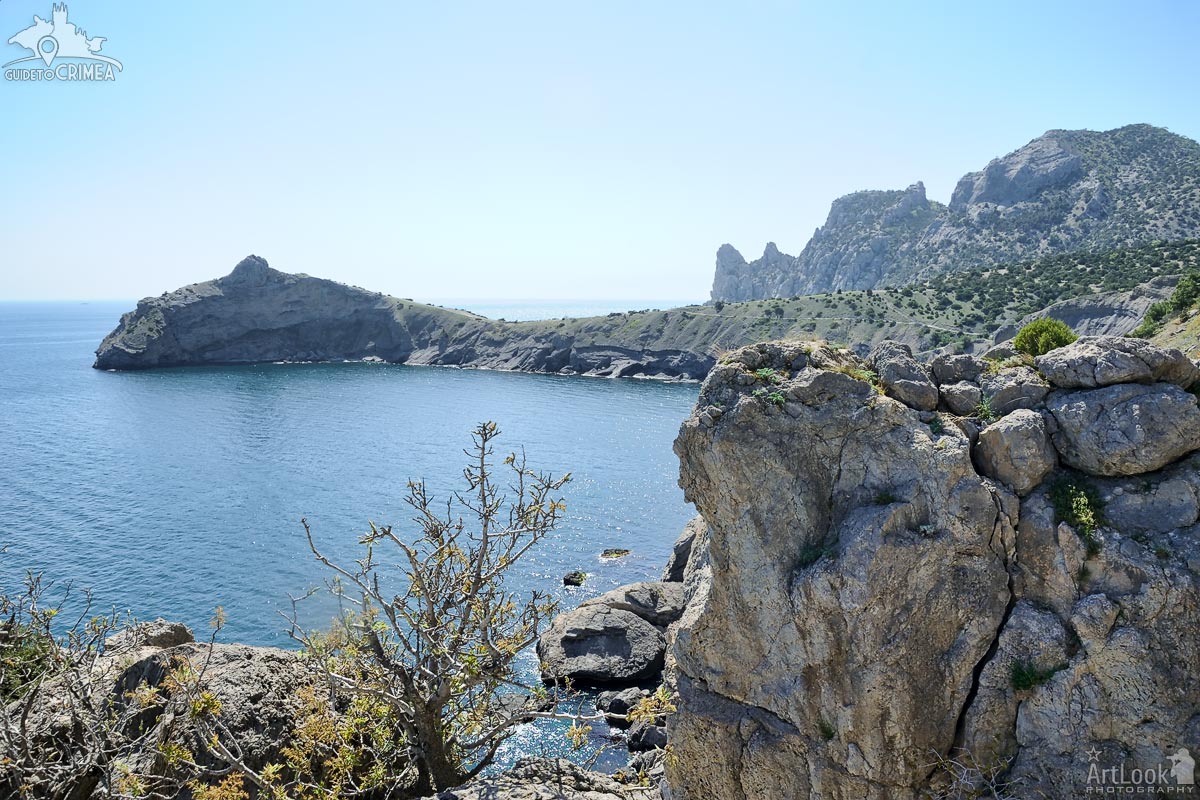
View from Golitsyn trail at the rocky seashore near Novy Svet (New World) settlement on the Cape Kapchik that resembles a head with long neck of a huge dinosaur drinking water from the Black Sea, in the old times, called the Russian Sea.
Photo #162 taken on May 01, 2017
| Album | Golitsyn Trail in Novy Svet |
| Category | Landscapes |
| Taken | May 1, 2017 |
| Uploaded | October 7, 2019 |

Golubaya Buhta (Blue Bay) is a captivating area of the Crimean coastline of Novy Svet (New World). On the steep slope of this rocky yet beautiful coastline grows a rare and solitary Stankevich pine tree that is endemic to Sudak (the south Crimean coast).
Also located in Golubaya Buhta (Blue Bay) is the famous Tsraskiy Plyazh (The Tsar’s Beach), so named because this was where Nicholas II enjoyed to swim during his visit to Novy Svet in 1912.
Photo #086 taken on September 02, 2015
| Album | Golitsyn Trail in Novy Svet |
| Category | Landscapes |
| Taken | September 2, 2015 |
| Uploaded | October 7, 2019 |
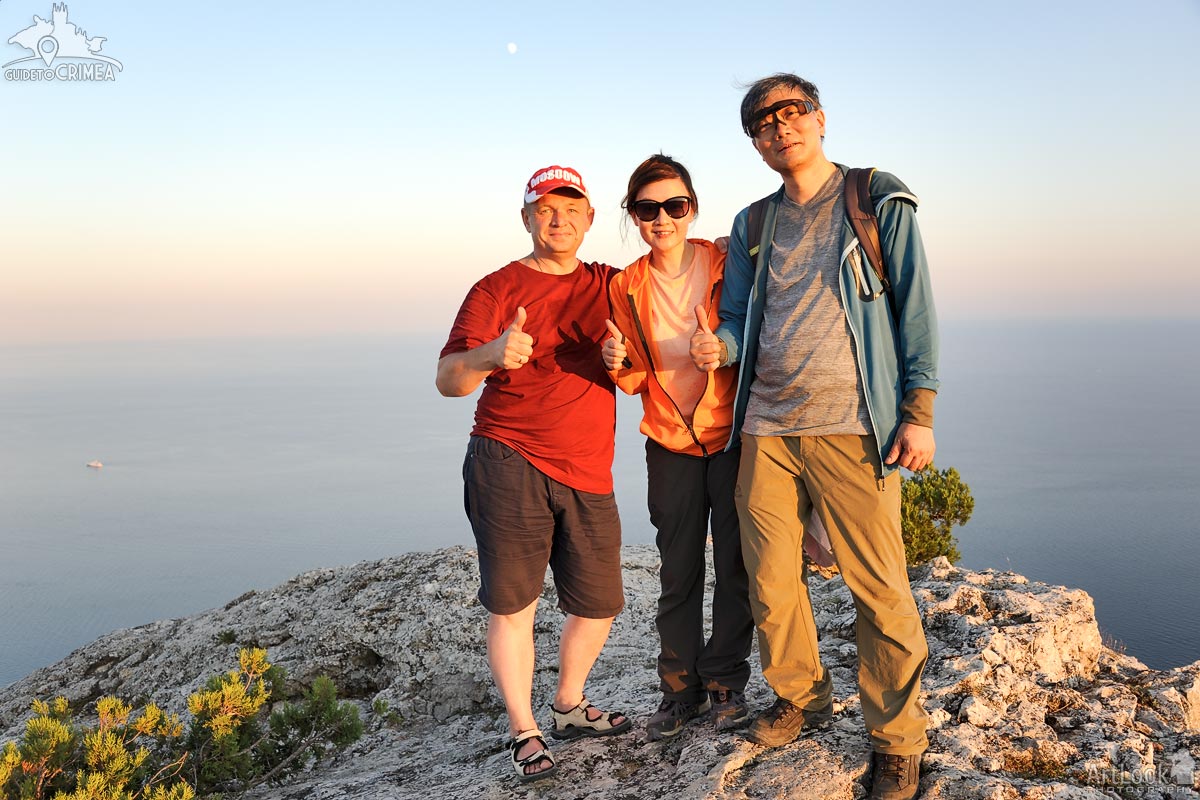
Memory photo of me, Arthur Lookyanov, and my clients and friends from Hong Kong, Esther and Ricky, standing on the peak of Sokol (Falcon) Mountain in Novy Svet (New World). The picture was taken on my camera by our local guide in Sudak after 2,5 hours climbing on the mount.
Photo #202 taken on August 11, 2019 during a hiking tour in Novy Svet on the 1st day of the adventure trip “Discovering Crimea in 6 Days”.

